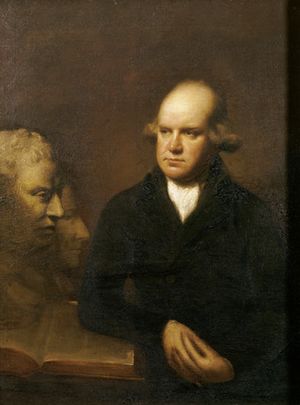Sir Herbert Croft, 5th Baronet facts for kids
Sir Herbert Croft, 5th Baronet (born November 1, 1751 – died April 26, 1816) was an English author. He is best known for his novel called Love and Madness.
The Life of Sir Herbert Croft
Herbert Croft was born in Dunster Park, Berkshire. His parents were Herbert Croft and Elizabeth Young. He went to University College, Oxford, in 1771. Later, he studied law at Lincoln's Inn. He became a lawyer, but in 1782, he went back to Oxford. He wanted to become a clergyman.
In 1786, he became the vicar of Prittlewell, Essex. However, he stayed in Oxford for several years. He was collecting information for a new English dictionary. Croft spent many years on this big project. He even used some work that Joseph Priestley had started. Croft found thousands of words that were not in other dictionaries. But, he could not find enough people to support the project. So, the dictionary was never finished.
Herbert Croft was married two times. The day after his second wedding, he was put in prison in Exeter because of money he owed.
He then moved to Hamburg, a city in Germany. Two years later, his collection of books was sold. In 1797, he became a baronet. This title came from a distant cousin, Sir John Croft, 4th Baronet. However, he did not get any family lands or money.
He returned to England in 1800. But he went abroad again in 1802. He lived near Amiens in France. He stayed in a house owned by Lady Mary Hamilton. She was the daughter of Alexander Leslie, 5th Earl of Leven. Later, he moved to Paris, France. He passed away there on April 26, 1816.
Sir Herbert Croft worked with Charles Nodier on some of his writing projects. Croft also wrote the life story of Edward Young. This story was included in a famous book called Lives of the Poets by Samuel Johnson.
About Love and Madness
In 1780, Herbert Croft published his novel, Love and Madness. The full title was Love and Madness, a Story too true, in a series of letters between Parties whose names could perhaps be mentioned were they less known or less lamented. This book was very popular and was printed seven times.
The story in the book is about a soldier named James Hackman. He fell in love with Martha Ray. She was connected to the Earl of Sandwich. Hackman shot Martha Ray as she was leaving Covent Garden in 1779.
Love and Madness is still interesting today for another reason. Croft included information about a young poet named Thomas Chatterton. Croft got letters from Chatterton's sister, Mrs. Newton. He used these letters without her permission or paying her.
When Robert Southey was preparing to publish Chatterton's works, he learned about Croft's actions. Southey wrote about it in a magazine in 1799. Croft wrote a reply to this. He sent it to John Nichols for another magazine. He also printed it separately as Chatterton and Love and Madness ... in 1800.
In his reply, Croft did not really answer the main problem. Instead, he wrote many harsh words about Southey. Southey and his friend Cottle worked together to show what Croft had done. They wanted to help Chatterton's sister, who was a widow and did not have much money. They also wanted to be the main editors of Chatterton's works.
Croft also provided information about Chatterton for a detailed account. This account was in Andrew Kippis's book called Biographia Britannica (volume 4, 1789).
Croft's Dictionary Project
In 1788, Herbert Croft wrote a letter to William Pitt. The letter was about creating a new dictionary. He felt that Samuel Johnson's dictionary could be improved. In 1790, Croft said he had collected 11,000 words. These words were used by good writers but were not in Johnson's dictionary.
Two years later, he suggested a new version of Johnson's Dictionary. But again, he could not find enough people to support it. So, his 200 volumes of handwritten notes were never used. Croft was a skilled scholar and knew many languages. He also wrote some interesting books in French.
Charles Nodier worked as a helper for Croft and his friend, Lady Mary Hamilton, in France. During this time, Nodier translated Hamilton's book Munster Village. He also helped her write La famille du duc de Popoli. This book was published in 1810.
The Love Letters of Mr H. and Miss R. 1775–1779 were put together from Croft's book. Mr. Gilbert Burgess edited them in 1895. You can also find more information in John Nichols's Illustrations ... (1828), pages 202–218.



